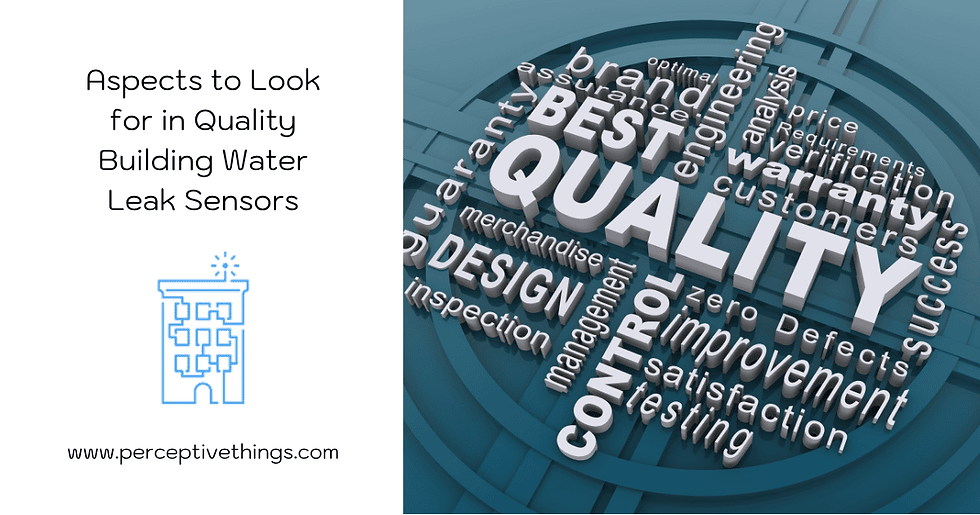Water Damage Risk Soars with COVID-19 Lockdowns
- Perceptive Things Team

- Jun 5, 2020
- 4 min read
Updated: Aug 19

COVID-19 has presented challenges to many industries, but the impact on residential multi-family buildings is rarely mentioned. Schools, offices, dining, and retail have been almost universally closed. Businesses that are able to shift their workforce to a remote work has resulted in a massive population of employees working from home. Schooling at home means whole families stay inside their homes most of the day. And cities are bereft of dine-out options or nightlife.
Significantly Increased Water Use

For some multi-family buildings, regional lockdowns have meant a sharp increase in 24-hour occupancy of tenants within the building. This means more cooking, more dishwashing, greater use of bathrooms, and generally increased use of water throughout the day. According to the home automation company Phyn, whose product can measure water use, their data shows a 21% increase in daily residential water use during the pandemic.
This increase in fixture and appliance use leads to greater wear and tear, and thus an increased chance of leaks developing. Water leaks are already a major problem for insurance companies. According to the Insurance Information Institute, billions of dollars are lost in non-weather-related water damage claims each year, with the average national claim exceeding $10,000 annually. In multi-family buildings, water damage is compounded by spreading the destruction across multiple units down a line. This can result in combined losses of hundreds of thousands to even millions of dollars.
Reduced Occupancy and Staffing During the Pandemic

Conversely, in some areas, residential buildings have seen a massive decrease in occupancy during the lockdown. In Manhattan, for example, our team has learned of many buildings with occupancy reduced by 50% to 75% as residents flee to suburban rentals and vacation homes for extended periods. Building operators have also been forced to significantly reduce staff presence to provide for the safety of building workers.
While the reduced occupancy has avoided the aforementioned problem of increased water use, it has introduced another problem. With fewer residents in the building and fewer staff, no one is around to observe when a leak develops. This can amplify losses as water flows into other unoccupied units, causing damage without one noticing. Even when someone finally notifies building management of the situation, reduced staffing can lead to even longer delays in locating the source of the leak and stemming the flow of water. A typical pinhole leak in a 60psi line results in 39 gallons of water escaping per minute, so every second counts.
Remote Monitoring Saves the Day

In both cases, Internet of Things (IoT) "smart building" technology can alleviate the risk of losses by keeping a constant eye out for damaging conditions, like water leaks. Sensors can detect the presence of water around fixtures, appliances, and HVAC units and instantly alert building operators of the situation, as well as its exact location. IoT monitoring systems can be used to remotely close valves to stem the flow of water and reduce or eliminate damage, without requiring the physical presence of building staff.
Such systems have been available for single-family homes for many years, but there have been few systems specifically designed for multi-story buildings that aren't priced so high that they can only be considered by enterprise-level organizations.
Whole-Building Water Damage Monitoring
Multi-family buildings need a professional solution that is designed to combat their unique issues. Beyond the usual risk of leaks from fixtures and appliances within apartments, these buildings have many more systems than an individual home, and the list of people responsible for maintaining those systems and responding to incidents, both in mechanical areas as well as within the apartments, rarely includes the tenants themselves.
Perceptive Things® provides a secure building-wide 915MHz wireless network, a suite of environmental sensors and actuators, and a cloud-based management platform that enables building operators to keep an eye out for damaging conditions, 24 hours a day, from anywhere in the world. Instant leak detection can trigger an actuator to close a valve and inform staff of a potentially damaging situation within seconds, massively expediting response times. Knowing exactly where an incident has occurred reduces the number of staff needed to locate the problem and stem the flow of water. Notifications can even be sent to staff not currently on-premises, giving operations teams a remote view into a building's health while protecting their health by reducing the need for them all to be on-site during the pandemic.
Fast ROI
Our solution is so cost-effective that a single saved claim can cover the cost for a building's entire Perceptive Things system for many years. But tenant peace-of-mind and preserving staff health is incalculable. Our technology is simple and non-invasive to install and can protect more than just water leaks. Temperature anomalies, door/window access, and a host of other environmental conditions can all be added a la carte, and on a flexible schedule, with little incremental cost. Our goal is to make it quick, easy, and cost-effective to make each building "smart", without the need for dedicated IT staff.




Comments